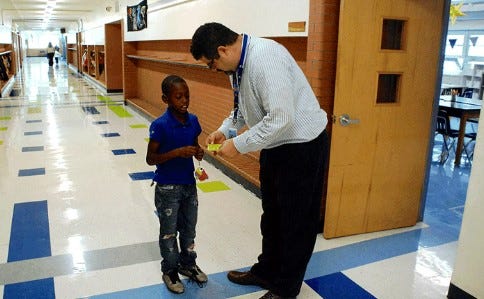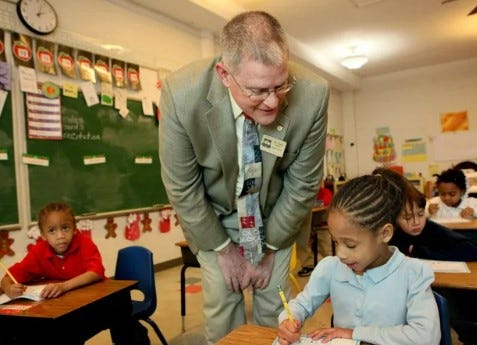So you might wonder what makes me qualified to speak about big changes that can - and should - be made in schools to increase both teacher and student productivity. I wasn’t a principal, or an AP, or a dean. The truth is you couldn’t pay me enough to fill those shoes. They are not easy and usually thankless jobs. They involve outrageous politics and an unusually high level of stifling hierarchy that limits any measurable advancement and positive change in a system that is designed to create positive change. But it is possible to make real change. Given my doctorate, I have been asked why I didn’t move up higher in the educational ranks. Thank you, but no thank you! Two reasons: First, as teacher you are in a position to do the most and best for students. Second, you couldn’t pay me enough to get me out of the classroom. I like being my own boss and in the classroom, I am the master of my own domain. I make the decisions (within school policies) and control my own policies, procedures and statistics.
Given that my professional background is not rooted in the education system actually gives me an edge for developing solutions in schools. Those working on the inside having exhausted all of the “inside the box” ideas for helping schools get back on track resulting in very limited success with often detrimental consequences (teacher morale, cell phones in schools, behavioral consequences, dress codes, etc). Now is the time to look outside the box. And instead of rejecting outside input, administrators should be actively recruiting and embracing changes from the outside as do all private sector professionals. In fact, most professional advances in the private sector come from other private sector outside sources - not from schools. When have you ever heard of a company seeking ideas from inside education on how to make their businesses run better, more efficiently and more productively? Right, never. But the opposite is true every day! Schools “appropriate” private sector stuff faster than a rat up a drainpipe!
Prior to teaching, I ran a high-volume highly data-driven practice for over 20 years, so I know what it takes to be a boss, how to be productive and how keep your employees happy. But being expertly skilled at being a chiropractor wasn’t enough to be a success. My real professional success came from corporate ideas: public speaking, marketing, goal setting, action plans, and other ideas rooted in practice management. Simply put, without looking outside of the healthcare window, my practice - and thousands of others - would never have experienced a fraction of the success that we all became.
Today’s post is about being the boss in a school - the principal - and one thing they can change to improve how to make their school better. Having taught in many schools has given me the opportunity to see a wide group of administrators in action who came from a diverse pool of candidates. Some rose through the ranks in their own school, others were brought in on the fly to fill a vacancy. I even had one who came from the corporate world, trained in the leadership program and two years later was running a school (which also proved why it is necessary to have extensive teaching experience to be a good principal). I have had one quickly removed and replaced with someone who unfortunately did not share the same vision of her predecessor’s positive changes. That school was doomed. In other words, as a former boss myself, I have seen how principals vary across the spectrum.
Just as in the private sector being a boss, or leader, of a school is easy if you do the right things. And to do the right things, change might as simple as putting classroom direction signs in the hallways, or possibly a drastic departure from the status quo. Some principals may think, “But that’s not how it’s done in schools.” And that is exactly the problem. Instead of seeking “problem-solving change”, schools all too often seek to maintain the delicate balancing act that is the current status. In business, this is known as the Kiss of Death. If you don’t grow, you die. Just look at schools today. Do you see growth and life or something else? And I do not count the hundreds of new apps as growth. In business, your livelihood depends on the ability to make multiple changes in a single day, or an hour, or a minute. If not, those you serve will not be satisfied and you will not make money. You want to see how the business model works? Watch Shark Tank. Fast, decisive and always looking out for their bottom line. Always in the customer’s best interest.
And when it comes to school staff, how wonderful it would be for principals to think more like small business owners. Taking great care of their employees so they will provide the best service possible to the most people - and produce the most income. I have seen principals (one, almost two) who actually worked this way.
In fact, the better you are at being a boss, the easier it is. I have known colleagues who had difficulty in managing their offices effectively, but I found it to be relaxing and enjoyable. Every day was a new challenge - not a new problem. I trained my staff thoroughly and constantly worked with them to refine their job goals and descriptions. The key was that I worked with my staff. We were all individual parts of a whole working together to accomplish one thing - to make the patient’s experience as productive and enjoyable as possible. If a problem arose, we solved it as a team. Our staff meetings (analogous to teacher PD’s) were always instructive and productive. We had them weekly and always came away with a game plan we could collectively agree on and that plan was always instituted right away. And while we all provided input, the weight of any decisions in the office always fell on my shoulders. I was the boss and the buck stopped with me. How many teachers have been in weekly meetings (live or Zoomed) where they are asked for input and no one says a word for fear of having to deal with the fallout? (Be honest, we all have.)
So you can imagine my confusion when I started teaching. Change was slow, bulky and inefficient. I soon found that the buck didn’t stop with the boss (the principal). It stopped with the teacher. And unless you find yourself working with a principal who understands the importance - the value - of his or her staff to the smooth running day-to-day operations of a school, the buck will always end up on the shoulders of teachers which will never best serve either students or parents. But here is something all principals can do to make life better for everyone.
Taking a different approach
Back to Charlie. This is a follow-up post to my previous article where I touched on how important informal administrative walk-throughs, or strolls, can - and should - become a vital component to any level of teacher observation. With so much changing in schools today, it is easy to lose sight of what is important, but if a school wants to have things run smoothly with everyone (teachers and students) doing the right things, four points can never be overlooked
Principals must put forth a constant presence in the hallways and classrooms. They must be omnipresent! I have taught in schools where I was mistaken for the principal more often than not by many of the students because I am tall and carry myself with an air of authority. This was not good as many students had never even met the principal! This principal stayed locked away in their office and never ventured out unless absolutely necessary. It was not good for teachers or students.
Teachers need to know that the principal always has their back - not sometimes, but always. In business, the customer is (or used to be) always right. In education, we teachers know that if anything goes south, the teacher is always wrong. This is no way to develop a loyal and dedicated staff.
Students need to know that the principal is the teacher’s friend. At the very least, this needs to be the impression for the students. This goes hand in hand with the previous point - which brings me to my favorite former principal, Charlie. I’ll leave off his last name but those who worked with him will know who I am talking about right away!
Timeliness - Problems need to be addressed as soon as they arise and corrective solutions need to be instituted ASAP. Unfortunately, the wheels of change turn slowly (if at all) in schools. Administrators need to understand that change is good and will be accepted by staff, students and parents much better than inaction especially if done with the very best of intentions. If the change doesn’t work, something else can always be instituted and on the upside, lessons will be learned from any failed proposals that may not have worked out. Changing how teacher observations are performed is an easy and positive change that can be made right away.
Let me tell you why Charlie stood out among all my other principals. This was only the second school I had taught in and while I had only one principal prior, everyone here said that “Charlie” was the best. I soon learned why. He was one of us and understood how important that was to the health of the school. We still talk about him to this day.
As I mentioned, I loved when administration would “pop into” my room to see how things were going, but Charlie took it one step further. He made unannounced visits (strolls) into my classroom virtually every week of the school year. He would come in with a big, “Good morning Dr. Cubbin and good morning class!” They would respond in kind with a hearty “Good Morning, Mr. Charlie (remember, no last names!) He would then walk around the classroom looking over students work and make comments to them along the way. The kids really looked up to him and got a kick out of this! His visits made them feel important!
Invariably, he would find some hooligan who wasn’t on task, give him a tap on the back of the head, and say, “Hey, pay attention, Dr. Cubbin is speaking!” The hooligans always knew he was playing with them and I think they secretly yearned to be the one chosen!
Now here comes the best part. As he was leaving, he would turn to the class and say, “You are very lucky to have a teacher as knowledgeable as Dr. Cubbin (about whatever I was teaching that day), so give him your undivided attention.” He would turn to me and say, “Thank you Dr. Cubbin. You’re doing a great job!” He did this every visit and his routine never varied. All the students knew he was the principal and they also knew that he had my back. Nobody messed around in my class. They knew they would have to answer to me, and then to Charlie. It was such a great place to teach. I only had Charlie as a principal for two years, but he made a lifelong impression on what makes a great principal. Charlie was the only principal who ever did this. It wasn’t a one-off thing. It happened virtually every week. Teachers came to expect this and saw it as a way of him validating our work. These weren’t technically observations, but they could have easily been.
So why do I tell you about Charlie? Last week when I spoke of reducing the number of formal observations and increasing the number of informal administrative strolls, this is what I was talking about. Charlie would spend 5 minutes in my room. He would see my big Goal Setting Board and if he wanted, he could have reviewed my classroom stats and wrapped up an informal observation (stroll) in all of under 10 minutes!
And isn’t it interesting. I started using the big Goal Setting Board while teaching under Charlie. When I came up with the idea (actually an idea I used in my office!) I ran it past a colleague and they weren’t too sure it would be acceptable, so I went to Charlie’s office (which could be knocked on at any time!) and proposed the idea. He thought it was great and gave me his full support. This is the kind of principal we all want to work for!
So principals, please remember who is the most important cog in the wheel of your school - your teachers! You want to see how this works? Do you want to change the culture of your school? Starting this week (starting today!) take a stroll around your building. Pop in and pop out. Don’t overstay your welcome. Don’t take notes, leave the iPad in your office, just pick a different wing of the building every day and take a stroll.







